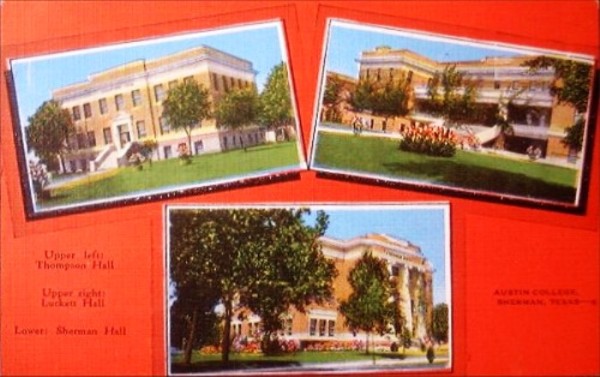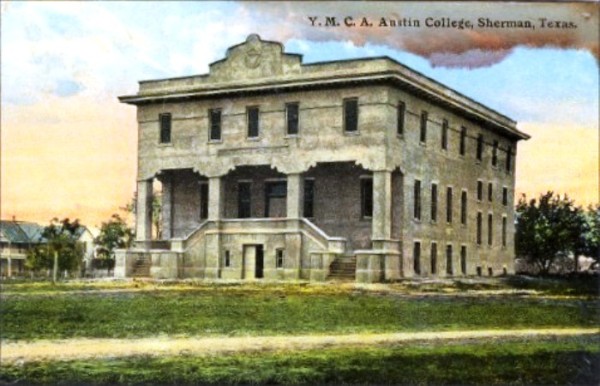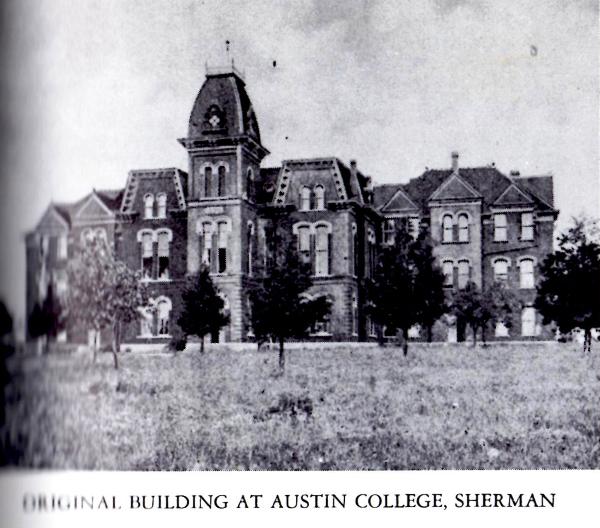 Sherman, Texas The
beginning of Austin College traces back April 3, 1840. The Presbytery
of the Brazos was determined to establish a four-year-college in Texas.
Rev. Daniel Baker secured the financial backing needed for the
project in 1849. The college began operation in Huntsville.
The members of the original board of trustees for Austin College included Rev. Daniel Baker, Sam Houston and Anson Jones. Rev. Samuel McKinney was the first president. The first building was a handsome Greek Revival structure with a cupola in which hung the college bell given by Sam Houston. Austin College continued at Huntsville until a severe epidemic of yellow fever convinced the trustees that a more healthful situation should be secured. Grayson County citizens responded to the offer of the college being moved to Sherman by donating a ten-acre campus and subscribing $32,000 for a building. The committee consisted of the Rev. R. E. Sherrill, F. M. Goode, C. C. Binkley, S. M. Luckett and B. McGregor. The first session, in the fall of 1876, of Austin College in Sherman began in the Odd Fellows' Hall. J. E. Wharton taught a class of forty-five students in the fall of 1876. Difficulties arose concerning the permanent campus being developed. The land was secured, deeded by M. G. Howe, F. A. Rice and Mr. Porter. The committee had begun construction of a building to be used for all functions of the college. Most of the subscribers had defaulted on their pledges. The contractor stopped working on the building after completing the lower floor and instituted a suit against some of the principal subscribers. The results were disastrous. Again, money was secured and L. F. Ely took over the construction contract and completed the building for $6,140. In 1877 the classes met in a frame building on Walnut Street. At the beginning of the 1878 school year, the local committee turned over to the college a new building. The brick building sported an impressive tower. On the lower floor were four classrooms divided to the right and left by a hall twelve feet wide. The chapel was located on the second floor which completed the facilities thought to be necessary for a four-year college. Originally, students had to find their own living quarters and pay for their boarding. Being that the campus was located in a fairly open country, it was soon evident that provisions for student housing was needful. The trustees granted permission to the college in 1879 to build private boarding and rooming houses on the campus. These buildings would remain on the campus and, being the property of the builders, they might be moved away as desired. Four or six four-room houses were built. The house built by Professor J. W. Moore was moved east of the campus to 1007 North Grand Avenue. At this time the faculty of Austin College consisted of Henry B. Boude, president; W. G. Richards; W. D. Vinson. The curriculum included Latin, Greek, history, mathematics, mineralogy, geology, chemistry, surveying, political economy, astronomy, physics, Paley's Evidence of Christianity, English literature, physical geography, physiology and hygiene. In 1882, J. G. Edmonds joined the faculty. In 1884-1885 through deaths and resignations of faculty members, Mr. Edmonds was the only teacher for the entire college. Numerous events caused the decline in enrollment the next year. Edmonds agreed with the trustees to operate the college and pay all expenses in return for $600. When the college opened, only eighteen boys enrolled. Mrs. Edmonds supported the family finances by cooking for the entire student body. By these measures, the school was debt free the next year. Mr. Edmonds resigned in 1889 and began the practice of law. Other situations to beset the college:
contributor unknown In
1913, after the burning of the administration building, Thompson Hall
was built and the Sherman citizens contributed funds for the building
of Sherman Hall. Thompson Hall; Luckett Hall; Sherman Hall At the beginning of World War I, Austin College faced extinction. The declined enrollment induced the trustees to admit women students. During the lack of funds to pay faculty members in the 1930s, the Grand Avenue Store and other Sherman businesses extended credit to the faculty members, who remained at their work.  contributor unknown Austin College's record of success:
 source: An Illustrated History of Grayson County, Texas by Graham Landrum, 1960, pg104-106 Austin College History Schools Susan Hawkins © 2024 If you find any of Grayson County TXGenWeb links inoperable, please send me a message. |